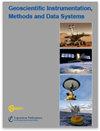A new tool for the estimation of Ground-Based InSAR acquisition characteristics before starting installation and monitoring survey
IF 2.3
4区 地球科学
Q3 GEOSCIENCES, MULTIDISCIPLINARY
Geoscientific Instrumentation Methods and Data Systems
Pub Date : 2023-11-21
DOI:10.5194/egusphere-2023-2489
引用次数: 0
Abstract
Abstract. Synthetic Aperture Radar (SAR) acquisition can be performed from satellites or from the ground by means of a so-called GB-InSAR (Ground-Based Interferometry SAR), but the signal emission and the output image geometry slightly differ between the two acquisition modes. Those differences are rarely mentioned in the literature. This paper proposes to compare satellite and GB-InSAR in terms of (1) acquisition characteristics and parameters to consider; (2) SAR image resolution; (3) geometric distortions that are foreshortening, layover and shadowing. If in the case of satellites SAR, the range and azimuth resolutions are known and constant along the orbit path, in the case of GB-InSAR their values are terrain-dependent. It is worth estimating the results of a GB-InSAR acquisition one can expect in terms of range and azimuth resolution, Line of Sight (LoS) distance and geometric distortions to select the best installation location when several are possible. We developed a tool which estimates those parameters from a Digital Elevation Model (DEM), knowing the GB-InSAR and the Slope of Interest (SoI) coordinates. This tool, written in MATLAB, was tested on a simple synthetic point cloud representing a cliff with a progressive slope angle to highlight the influence of the SoI geometry on the acquisition characteristics and on two real cases; cliffs located in Switzerland, one in the Ticino canton and on in the Vaud canton.一种用于地基InSAR采集特性预估的新工具
摘要。合成孔径雷达(SAR)的采集可以从卫星上进行,也可以通过所谓的GB-InSAR(地基干涉SAR)从地面进行,但是两种采集模式之间的信号发射和输出图像几何形状略有不同。这些差异在文献中很少被提及。本文提出了卫星与GB-InSAR在以下方面的比较:(1)采集特性和需要考虑的参数;(2) SAR图像分辨率;(3)缩短、停留和阴影等几何畸变。如果在卫星SAR的情况下,距离和方位角分辨率是已知的,并且沿着轨道路径是恒定的,那么在GB-InSAR的情况下,它们的值与地形有关。在可能的情况下,从距离和方位角分辨率、视线(LoS)距离和几何畸变等方面估计GB-InSAR采集的结果是值得的,以便选择最佳安装位置。我们开发了一种工具,可以根据数字高程模型(DEM)估计这些参数,知道GB-InSAR和兴趣斜率(SoI)坐标。该工具是用MATLAB编写的,在一个简单的合成点云上进行了测试,该点云代表一个坡度渐变的悬崖,以突出SoI几何形状对采集特性的影响,并在两个实际案例中进行了测试;悬崖位于瑞士,一个在提契诺州,另一个在沃州。
本文章由计算机程序翻译,如有差异,请以英文原文为准。
求助全文
约1分钟内获得全文
求助全文
来源期刊

Geoscientific Instrumentation Methods and Data Systems
GEOSCIENCES, MULTIDISCIPLINARYMETEOROLOGY-METEOROLOGY & ATMOSPHERIC SCIENCES
CiteScore
3.70
自引率
0.00%
发文量
23
审稿时长
37 weeks
期刊介绍:
Geoscientific Instrumentation, Methods and Data Systems (GI) is an open-access interdisciplinary electronic journal for swift publication of original articles and short communications in the area of geoscientific instruments. It covers three main areas: (i) atmospheric and geospace sciences, (ii) earth science, and (iii) ocean science. A unique feature of the journal is the emphasis on synergy between science and technology that facilitates advances in GI. These advances include but are not limited to the following:
concepts, design, and description of instrumentation and data systems;
retrieval techniques of scientific products from measurements;
calibration and data quality assessment;
uncertainty in measurements;
newly developed and planned research platforms and community instrumentation capabilities;
major national and international field campaigns and observational research programs;
new observational strategies to address societal needs in areas such as monitoring climate change and preventing natural disasters;
networking of instruments for enhancing high temporal and spatial resolution of observations.
GI has an innovative two-stage publication process involving the scientific discussion forum Geoscientific Instrumentation, Methods and Data Systems Discussions (GID), which has been designed to do the following:
foster scientific discussion;
maximize the effectiveness and transparency of scientific quality assurance;
enable rapid publication;
make scientific publications freely accessible.
 求助内容:
求助内容: 应助结果提醒方式:
应助结果提醒方式:


